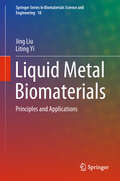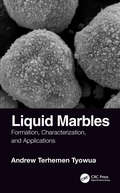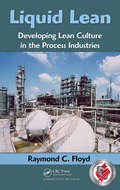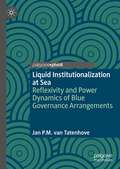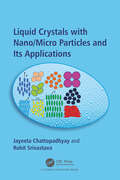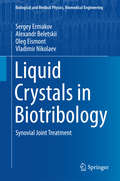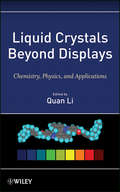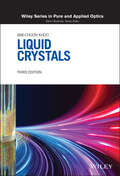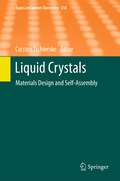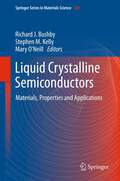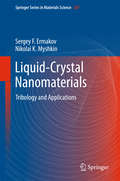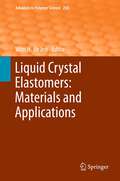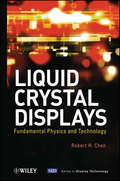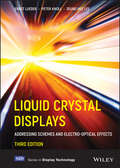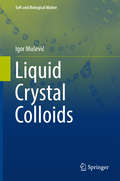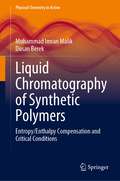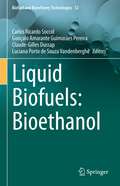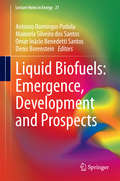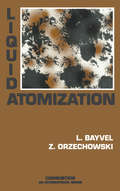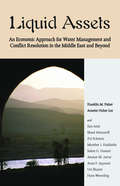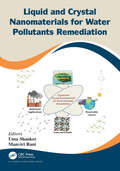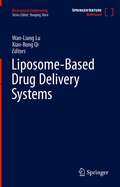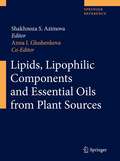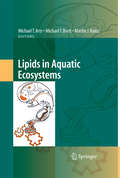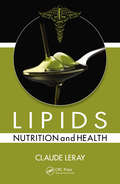- Table View
- List View
Liquid Metal Biomaterials: Principles and Applications (Springer Series in Biomaterials Science and Engineering #10)
by Jing Liu Liting YiThis is the first-ever book to illustrate the principles and applications of liquid metal biomaterials. Room-temperature liquid metal materials are rapidly emerging as next-generation functional materials that display many unconventional properties superior to those of conventional biomaterials. Their outstanding, unique versatility (“one material, diverse capabilities”) opens many exciting opportunities for the medical sciences. The book reviews representative applications of liquid metal biomaterials from both therapeutic and diagnostic aspects. It also discusses related efforts to employ liquid metals to overcome today’s biomedical challenges. It will provide readers with a comprehensive understanding of the technical advances and fundamental discoveries on the frontier, and thus equip them to investigate and utilize liquid metal biomaterials to tackle various critical problems.
Liquid Marbles: Formation, Characterization, and Applications
by Andrew T. TyowuaCertain small solid particles are surface-active at fluid interfaces and thus are able to stabilize materials previously considered impossible to stabilize in their absence. Liquid marbles, particle-coated non-sticking liquid droplets, represent one of these materials. Preparation of liquid marbles was described only about 15 years ago and they are now widely studied by many research groups and numerous applications of liquid marbles have been advanced. The book is written for postgraduates and researchers working on the area who are training to become chemists, soft matter physicists, materials scientists, and engineers.
Liquid Lean: Developing Lean Culture in the Process Industries
by Raymond C. FloydWhile Lean practices have been successfully implemented into the process industry with excellent results for over 20 years (including the author‘s own award winning example at Exxon Chemical), that industry has been especially slow in adopting Lean. Part of the problem is that the process industry needs its own version of Lean. The larger part of t
Liquid Institutionalization at Sea: Reflexivity and Power Dynamics of Blue Governance Arrangements
by Jan P.M. van TatenhoveThis book presents an innovative theory of liquid institutionalization at sea and explores the building blocks of this theory focusing in particular on institutionalization, blue governance arrangements, reflexivity and power. The book opens with an overview of stability and change in new institutional theory before moving on to discuss liquid institutionalization in more detail. The author applies this approach to three different cases: Arctic shipping; deep seabed mining; and transboundary regionalization in Europe. For each of these cases the book describes the emerging blue governance arrangements, the type of liquid institutionalization and the consequences this has for power and reflexivity.
Liquid Crystals with Nano/Micro Particles and Their Applications
by Jayeeta Chattopadhyay Rohit SrivastavaLCs are self-organized anisotropic fluids that are thermodynamically located between the isotropic liquid and the crystalline phase, exhibiting the fluidity of liquids as well as the long-range lattice order that can only be found in crystalline solids. The addition of nanomaterials to a LC material produces a composite or colloidal dispersion and results into a revolutionary change in their applications. This book will discuss the remarkable performances of nano-particle aided liquid crystals in metamaterials, photonics, functionalized polymer fibres, sensing, and medical diagnostics.
Liquid Crystals in Biotribology
by Sergey Ermakov Alexandr Beletskii Oleg Eismont Vladimir NikolaevThis book summarizes the theoretical and experimental studies confirming the concept of the liquid-crystalline nature of boundary lubrication in synovial joints. It is shown that cholesteric liquid crystals in the synovial liquid play a significant role in the mechanism of intra-articular friction reduction. The results of structural, rheological and tribological research of the creation of artificial synovial liquids containing cholesteric liquid crystals in natural synovial liquids are described. These liquid crystals reproduce the lubrication properties of natural synovia and provide a high chondroprotective efficiency. They were tested in osteoarthritis models and in clinical practice.
Liquid Crystals Beyond Displays: Chemistry, Physics, and Applications
by Quan LiThe chemistry, physics, and applications of liquid crystals beyond LCDs Liquid Crystals (LCs) combine order and mobility on a molecular and supramolecular level. But while these remarkable states of matter are most commonly associated with visual display technologies, they have important applications for a variety of other fields as well. Liquid Crystals Beyond Displays: Chemistry, Physics, and Applications considers these, bringing together cutting-edge research from some of the most promising areas of LC science. Featuring contributions from respected researchers from around the globe, this edited volume emphasizes the chemistry, physics, and applications of LCs in areas such as photovoltaics, light-emitting diodes, filed-effect transistors, lasers, molecular motors, nanophotonics and biosensors. Specific chapters look at magnetic LCs, lyotropic chromonic LCs, LC-based chemical sensors, LCs in metamaterials, and much more. Introducing readers to the fundamentals of LC science through the use of illustrative examples, Liquid Crystals Beyond Displays covers not only the most recent research in the myriad areas in which LCs are being utilized, but also looks ahead, addressing potential future developments. Designed for physicists, chemists, engineers, and biologists working in academia or industry, as well as graduate students specializing in LC technology, this is the first book to consider LC applications across a wide range of fields.
Liquid Crystals (Wiley Series in Pure and Applied Optics)
by Iam-Choon KhooThe latest edition of the leading resource on the properties and applications of liquid crystals In the newly revised Third Edition of Liquid Crystals, Professor Iam Choon Khoo delivers a comprehensive treatment of the fundamentals and applied aspects of optical physics, light scattering, electro-optics, and non-linear optics of liquid crystals. The book's opening chapters include coverage of the foundational physics and optical properties of liquid crystals and lead to more advanced content on the display, photonics and nonlinear optics applications of liquid crystals. New topics, including photonic crystals, metamaterials, ultrafast nonlinear optics, and fabrication methods for massive cholesteric and blue phase liquid crystals are discussed at length. Analytical methods and experimental observations of nonlinear light propagation through liquid crystalline and anisotropic materials and devices are also discussed. Liquid Crystals offers an insightful and unique treatment of the nonlinear optics of liquid crystals. New and expanded sections round out this new edition and add to the most up-to-date resource on this topic available today. The book also includes: A thorough introduction to liquid crystals, including their molecular structures, chemical compositions, order parameter, phase transition, and free energies Practical discussions of nematic, cholesteric, smectic, and ferroelectric liquid crystals, and explorations of linear and nonlinear light scattering in these phases. A detailed quantum mechanical treatment of the linear and nonlinear electronic optical response of liquid crystal molecules to optical fields. A self-contained discussion of the fundamentals of nonlinear optics/photonics and comprehensive review of all liquid crystalline materials-based nonlinear optical processes and applications. The latest edition of Liquid Crystals is an indispensable resource for graduate students, professors, research scientists and engineers in industrial or government laboratories. It's also an ideal reference for anyone seeking a one-stop textbook with complete coverage of the optical, electro-optical, and non-linear optical properties and processes of liquid crystals.
Liquid Crystals
by Carsten TschierskeFluorinated Liquid Crystals: Design of Soft Nanostructures and Increased Complexity of Self-Assembly by Perfluorinated Segments, by Carsten Tschierske Liquid Crystalline Crown Ethers, by Martin Kaller and Sabine Laschat Star-Shaped Mesogens - Hekates: The Most Basic Star Structure with Three Branches, by Matthias Lehmann DNA-Based Soft Phases, by Tommaso Bellini, Roberto Cerbino and Giuliano Zanchetta Polar and Apolar Columnar Phases Made of Bent-Core Mesogens, by N. Vaupotič, D. Pociecha and E. Gorecka Spontaneous Achiral Symmetry Breaking in Liquid Crystalline Phases, by H. Takezoe Nanoparticles in Liquid Crystals and Liquid Crystalline Nanoparticles, by Oana Stamatoiu, Javad Mirzaei, Xiang Feng and Torsten Hegmann Stimuli-Responsive Photoluminescent Liquid Crystals, by Shogo Yamane, Kana Tanabe, Yoshimitsu Sagara and Takashi Kato
Liquid Crystalline Semiconductors
by Richard J. Bushby Mary O'Neill Stephen M. KellyThis is an exciting stage in the development of organic electronics. It is no longer an area of purely academic interest as increasingly real applications are being developed, some of which are beginning to come on-stream. Areas that have already been commercially developed or which are under intensive development include organic light emitting diodes (for flat panel displays and solid state lighting), organic photovoltaic cells, organic thin film transistors (for smart tags and flat panel displays) and sensors. Within the family of organic electronic materials, liquid crystals are relative newcomers. The first electronically conducting liquid crystals were reported in 1988 but already a substantial literature has developed. The advantage of liquid crystalline semiconductors is that they have the easy processability of amorphous and polymeric semiconductors but they usually have higher charge carrier mobilities. Their mobilities do not reach the levels seen in crystalline organics but they circumvent all of the difficult issues of controlling crystal growth and morphology. Liquid crystals self-organise, they can be aligned by fields and surface forces and, because of their fluid nature, defects in liquid crystal structures readily self-heal. With these matters in mind this is an opportune moment to bring together a volume on the subject of 'Liquid Crystalline Semiconductors'. The field is already too large to cover in a comprehensive manner so the aim has been to bring together contributions from leading researchers which cover the main areas of the chemistry (synthesis and structure/function relationships), physics (charge transport mechanisms and optical properties) and potential applications in photovoltaics, organic light emitting diodes (OLEDs) and organic field-effect transistors (OFETs). This book will provide a useful introduction to the field for those in both industry and academia and it is hoped that it will help to stimulate future developments.
Liquid-Crystal Nanomaterials
by Sergey F. Ermakov Nikolai K. MyshkinThis book discusses the tribological, rheological and optical properties of liquid-crystal nanomaterials as well as lubricant media. It also describes the formation of liquid-crystal materials and the application of cholesteric liquid-crystal compounds in technical friction units and in human and animal joints. Further, it shows the connection between the tribological and other physical properties of liquid-crystal cholesterol compounds and develops a lubricity conceptual model of cholesteric–nematic, liquid-crystalline nanostructures on the basis of physical and energetic interpretations. This general model is valid for all surfaces and friction pairs, including biopolymers, and could lead to applications of cholesteric liquid-crystalline nanomaterials in different friction units and tribosystems as well as in the treatment of joint diseases.
Liquid Crystal Elastomers: Materials and Applications
by Wim H. de JeuPreparation of Liquid Crystalline Elastomers, by F. Brömmel, D. Kramer, H. Finkelmann Applications of Liquid Crystalline Elastomers, by C. Ohm, M. Brehmer und R. Zentel Liquid Crystal Elastomers and Light, by Peter Palffy-Muhoray Electro-Opto-Mechanical Effects in Swollen Nematic Elastomers, by Kenji Urayama The Isotropic-to-Nematic Conversion in Liquid Crystalline Elastomers, by Andrija Lebar, George Cordoyiannis, Zdravko Kutnjak und Bostjan Zalar Order and Disorder in Liquid-Crystalline Elastomers, by Wim H. de Jeu und Boris I. Ostrovskii
Liquid Crystal Displays
by Robert H. ChenAn unprecedented look into the basic physics, chemistry, and technology behind the LCDMost notably used for computer screens, televisions, and mobile phones, LCDs (liquid crystal displays) are a pervasive and increasingly indispensable part of our lives. Providing both an historical and a business-minded context, this extensive resource describes the unique scientific and engineering techniques used to create these beautiful, clever, and eminently useful devices.In this book, the history of the science and technology behind the LCD is described in a prelude to the development of the device, presenting a rational development theme and pinpointing innovations. The book begins with Maxwell's theory of electromagnetism, and the ultimately profound realization that light is an electromagnetic wave and an electromagnetic wave is light.The power of mathematical physics thus was brought to bear upon the study of light, and particularly the polarization of light by material bodies, including liquid crystals. After a brief historical description of polarization, a physical interpretation provides substance to the mathematical concepts. Subsequent chapters cover:Thermodynamics for liquid crystalsThe Maier-Saupe mean field, phenomenological, static continuum, and dynamic continuum theoriesThe transistor and integrated circuitGlass, panels, and modulesThe calculus of variationsThe active matrixSemiconductor fabricationThe global LCD businessAdditionally, the book illustrates how mathematics, physics, and chemistry are put to practical use in the LCDs we use every day. By describing the science from an historical perspective and in practical terms in the context of a device very familiar to readers, the book presents an engaging and unique view of the technology for everyone from science students to engineers, product designers, and indeed anyone curious about LCDs.Series Editor: Anthony C. Lowe, The Lambent Consultancy, Braishfield, UKThe Society for Information Display (SID) is an international society, which has the aim of encouraging the development of all aspects of the field of information display. Complementary to the aims of the society, the Wiley-SID series is intended to explain the latest developments in information display technology at a professional level. The broad scope of the series addresses all facets of information displays from technical aspects through systems and prototypes to standards and ergonomics.
Liquid Crystal Displays: Addressing Schemes and Electro-Optical Effects (Wiley Series in Display Technology)
by Ernst Lueder Seung Hee Lee Peter KnollLIQUID CRYSTAL DISPLAYS THE NEW EDITION OF THE GOLD-STANDARD IN TEACHING AND REFERENCING THE FUNDAMENTALS OF LCD TECHNOLOGIES This book presents an up-to-date view of modern LCD technology. Offering balanced coverage of all major aspects of the field, this comprehensive volume provides the theoretical and practical information required for the development and manufacture of high-performance, energy-efficient LCDs. The third edition incorporates new technologies and applications throughout. Several brand-new chapters discuss topics such as the application of Oxide TFTs and high mobility circuits, high-mobility TFT-semiconductors in LCD addressing, liquid crystal displays in automotive instrument clusters and touch-screen systems, and the use of ultra-high-resolution LCD panels in augmented reality (AR) and virtual reality (VR) displays. This practical reference and guide: Provides a complete account of commercially relevant LCD technologies, including their physics, mathematical descriptions, and electronic addressing Features extensively revised and expanded information, including more than 150 pages of new material Includes the addition of Oxide Transistors and their increased mobilities, the advances of fringe field switching and an overview of automotive displays Presents quantitative results with full equation sets, their derivation, and tabular summaries of related information sets
Liquid Crystal Colloids
by Igor MuševičThis book brings together the many concepts and discoveries in liquid crystal colloids contributed over the last twenty years and scattered across numerous articles and book chapters. It provides both a historical overview of the development of the field and a clear perspective on the future applications in photonics. The book covers all phenomena observed in liquid crystal colloids with an emphasis on experimental tools and applications of topology in condensed matter, as well as practical micro-photonics applications. It includes a number of spectacular manifestations of new topological phenomena not found or difficult to observe in other systems. Starting from the early works on nematic colloids, it explains the basics of topological defects in ordered media, charge and winding, and the elastic forces between colloidal particles in nematics. Following a detailed description of experimental methods, such as optical tweezing and particle tracking, the book eases the reader into the theoretical part, which deals with elastic deformation of nematic liquid crystals due to inclusions and surface alignment. This is discussed in the context of basic mean field Landau-de Gennes Q-tensor theory, with a brief explanation of the free-energy minimization numerical methods. There then follows an excursion into the topology of complex nematic colloidal structures, colloidal entanglement, knotting and linking. Nematic droplets, shells, handlebodies and chiral topological structures are addressed in separate chapters. The book concludes with an extensive chapter on the photonic properties of nematic dispersions, presenting the concept of integrated soft matter photonics and discussing the concepts of nematic and chiral nematic microlasers, surface-sensitive photonic devices and smectic microfibers. The text is complemented by a large bibliography, explanatory sketches and beautiful micrographs.
Liquid Chromatography of Synthetic Polymers: Entropy/Enthalpy Compensation and Critical Conditions (Physical Chemistry in Action)
by Muhammad Imran Malik Dusan BerekThis book elucidates the peculiar phenomenon of entropy/enthalpy compensation that takes place in high performance liquid chromatography (HPLC) of polymers. Numerous publications, including some books, are devoted to molecular characterization of synthetic polymers, materials presently produced in large and steadily growing quantities, applying methods of HPLC. A knowledge of the molecular characteristics of polymers is indispensable, not only for their proper applications but also for their recycling and remediation. Polymer scientists generally focus on synthesis and potential applications of polymers while not giving due attention to an important central link, their comprehensive characterization in context of development of structure-property correlations. To fill this gap is one of the aims of the present book. The process of entropy/enthalpy compensation plays a decisive role in the advanced method of polymer characterization such as liquid chromatography at critical conditions, eluent gradient interaction chromatography, and temperature gradient interaction chromatography. All chemists working on any aspect of polymer science will find this book a valuable resource for the development of structure-property correlations.
Liquid Biofuels: Bioethanol (Biofuel and Biorefinery Technologies #12)
by Carlos Ricardo Soccol Gonçalo Amarante Guimarães Pereira Claude-Gilles Dussap Luciana Porto de Souza VandenbergheThis book covers the present and future of bioethanol biorefinery technologies. It discusses the efficient use of feedstock in bioethanol production, and critically reviews the environmental sustainability of bioethanol production. In addition, it describes the integrated production of bioelectricity, biopolymers, organic acids, and other biomolecules, as well as the use of process-related liquid and solid byproducts and/or wastes during bioethanol generation.Since the bioethanol industry has also led the automotive industry to explore new avenues, this book summarizes the various aspects of ethanol motorization, hybrid engine development, and biofuel electrification. For decades, clean and renewable alternatives have been sought to reduce dependence on petroleum-based fossil fuels and CO2 emissions. Bioethanol appears as one of the best solutions for the production of biofuels, bioenergy and biochemicals, along with the establishment of new biorefinery concepts and a circular bioeconomy. Therefore, the ideas and technologies presented in this book contribute to the UN Sustainable Development Goal 7: Affordable and Clean Energy.This book is a useful reference for postgraduate students and researchers interested in biorefinery and biofuel technologies, both in academia- and commercial laboratories. Early career scientists can use it to fast track into the field. Advanced scientists will find it helpful to gain a broader overview of the field beyond their area of specialization.
Liquid Biofuels: Emergence, Development and Prospects
by Antonio Domingos Padula Manoela Silveira Santos Omar Inácio Benedetti Santos Denis BorensteinBioenergy is coming to be seen as a priority on the international agenda, with the use of liquid biofuels a key strategy in the attempt to meet both the demand for environmental sustainability and the energy needs of countries. The growth in the production and use of biofuels around the world has led to increased interest and discussion about this subject. Given the dynamics of this phenomenon, the organizers of this book, based on more than 10 years experience of joint research on this subject, seek to address key issues relating to the production and marketing of liquid biofuels using the Brazilian experience with ethanol and biodiesel as an illustrative case, as well as the experiences of the leading producers and consumers of biofuels. The topics to be covered in this book include the role of public policies in fostering the emergence of the biofuels industry, the main socio-economic, environmental, technological aspects and the prospects for the sector. The conceptual and methodological bases that provide analytical support to the book are based on recent research published in indexed journals. The structure and content of the book seek to address some central issues regarding: How the biofuel industries have emerged and developed in different countries? What factors have been crucial to the success or failure of different production initiatives? What are the main socio-economic-environmental impacts of the production and consumption of liquid biofuels? How are national and international markets for liquid biofuels being structured? To what extent and/or in what conditions can the experiences and lessons learned at the national level be transferred and adapted in other countries? Finally, based on the scenarios, the prospects for liquid biofuels will be discussed.
Liquid Atomization
by L.P. BayvelCovering the basics of liquid atomization, this book familiarizes readers with the physical processes of liquid atomization, the main types of atomizers and their design, measurements of spray characteristics, experimental investigations of atomizers, and application of atomizers. It demonstrates how to calculate and design atomizers and how to mea
Liquid Assets: An Economic Approach for Water Management and Conflict Resolution in the Middle East and Beyond
by Franklin Fisher Annette Huber-LeeLiquid Assets shows that the common view of water as an inevitable cause of future wars is neither rational nor necessary. Typically, two or more parties with claim to the same water sources are thought to play a zero-sum game with each side placing a high emotional and political value over the ownership of the water. However, Franklin Fisher and his coauthors demonstrate that when disputes in ownership are expressed as disputes about money values, in most cases, the benefits of ownership will be surprisingly small. By assigning an economic value to water and treating water as a tradable resource, parties see that the gains from cooperation exceed the costs resulting from the change in ownership. A zero-sum game becomes a win-win situation. To support this new approach, Liquid Assets presents an innovative water allocation model that can be used to assist water management, the cost-benefit analysis of water infrastructure, and the resolution of disputes. The model takes system-wide effects into account and is the first to overcome the failure of actual water markets to cope with the divergence between social and private benefits (as implied by agricultural subsidies), permitting the model-user to impose his or her own values or policies. Liquid Assets applies its methodology to Israel, Jordan, and Palestine, a region where water is scarce and water conflicts are often thought to be explosive. Indeed, this book is the result of a joint effort of Israeli, Jordanian, Palestinian, American, and Dutch experts. But the book‘s message and methods are not restricted to the Middle East. They are applicable to water management and water disputes around the globe.
Liquid and Crystal Nanomaterials for Water Pollutants Remediation
by Uma ShankerNanoscience technology is playing a vital role in multidisciplinary research due to its unique characteristics at nanoscale as compared to bulk materials. In view of such excellent properties, like high surface area, semiconducting nature, and non-toxicity, nanotechnology has emerged as a promising means to curb pollution. Liquid and crystal nanomaterials aim for products and processes that are ecofriendly, economically sustainable, safe, and energy-efficient. One of the most popular fields widely adopted is photocatalysis of nanomaterials that involves photo-conduction in efficient removal/degradation of noxious pollutants. This book focuses on generation of liquid and crystal nanomaterials for environmental remediation.
Liposome-Based Drug Delivery Systems (Biomaterial Engineering)
by Wan-Liang Lu Xian-Rong QiThis volume describes the protocols for fabrication of liposomal drug delivery system, and consists of two parts. The first part emphasizes the basic protocols and concepts for fabrication of drug-loaded liposomes. For new investigators, laying the groundwork is the first step. This part focuses on the fabrication details in liposomes formulations, which are the so-called small tricks while usually not disclosed in mostly published research articles. However, these processing details are crucial for the preparation of liposomes. And the second part focuses on the strategies in modified and/or functionalized liposomes to adapt to pathophysiological environment, as well as their application in treating diseases. As new analytical and synthetic technologies become available, and improved understanding of pathophysiology, various functionalized drug liposomes are developing to fit the requirements of different therapeutic purposes, exhibiting a broad range of applications. Accordingly, the objectives of this part are aimed at deeply unearthing the formulation of drug-loaded liposomes, describing the detailed operation of liposomal formulation, and further demonstrating their potential applications. Therefore, this volume shows the features of experimental report or protocol for proving a guide to scientists, research students, and young investigators in pharmaceutical enterprises.
Lipids, Lipophilic Components and Essential Oils from Plant Sources
by Shakhnoza S. Azimova Valentina I. Vinogradova Anna I. GlushenkovaA comprehensive collection covering more than 3,000 plants Offers systematic information on the lipids and natural oils that can be extracted from each part of the plant Includes material not previously readily available in English
Lipids in Aquatic Ecosystems
by Martin Kainz Michael T. Arts Michael T. BrettEvidence now suggests that the roles of essential fatty acids as growth promoters and as indices of health and nutrition are fundamentally similar in freshwater and marine ecosystems. Lipids in Aquatic Ecosystems integrates this divergent literature into a coordinated, digestible form. Chapters are organized so as to discuss and synthesize the flow of lipids from lower to higher trophic levels, up to and including humans. Linkages between the production, distribution and pathways of these essential compounds within the various levels of the aquatic food webs, and their ultimate uptake by humans and other terrestrial organisms, are highlighted throughout the book. This book will be of interest to researchers and resource managers working with aquatic ecosystems.
Lipids: Nutrition and Health
by Claude LerayThe role of lipids in nutrition science has evolved considerably in the past decade with new concepts following new discoveries. Lipids: Nutrition and Health reviews the role of dietary lipids in maintaining health, bringing the latest knowledge from a myriad of sources into one convenient resource. Taking a combined approach that integrates lipid
